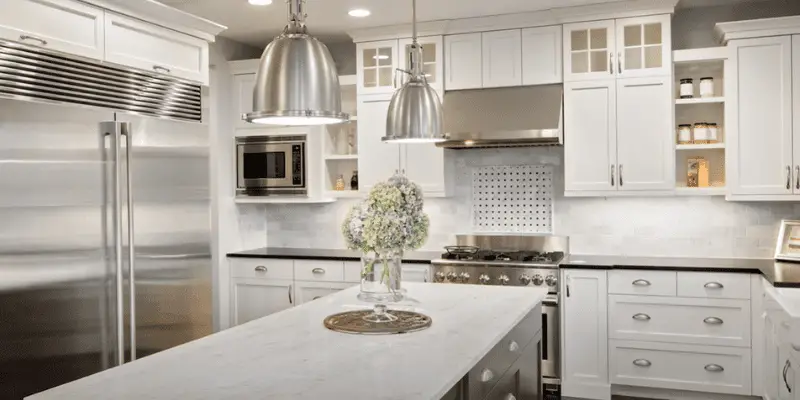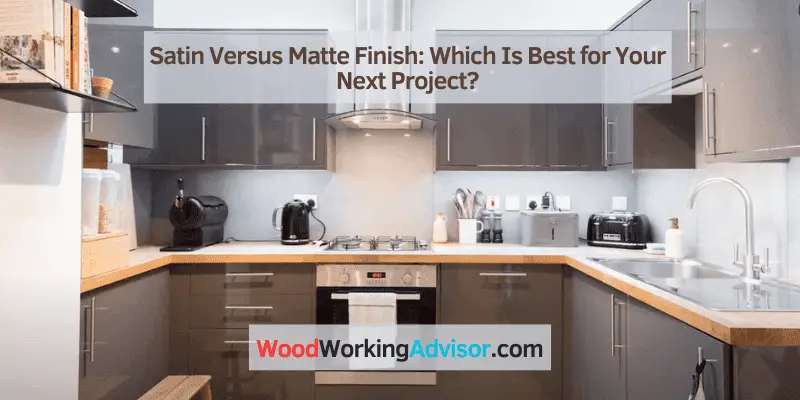Satin and matte finishes are two popular options for surfaces, but they differ in terms of sheen. Manufacturers achieve a satin finish by blending matte and gloss finishes.
On the other hand, matte finishes feature a low sheen, making them ideal for creating a soft, elegant look. Both finishes offer unique benefits and the choice between them ultimately depends on the desired aesthetic and the surface’s intended use.
While satin finishes add a hint of shine without being too glossy, matte finishes provide a velvety, non-reflective appearance. Understanding the characteristics of each finish can help you make an informed decision when selecting the best option for your project. We’ll delve into the differences between satin and matte finishes to help you determine which is the right choice for your specific needs.
Explaining Satin And Matte Finishes
When it comes to interior design and home renovation, choosing the right finish for your surfaces can make a significant impact on the overall aesthetic of a space. Satin and matte finishes are both popular choices for a variety of applications, offering unique characteristics and appearances. Understanding the differences between these two types of finishes can help you make informed decisions when selecting the perfect look for your home.
Definition Of Satin Finish
A satin finish is a smooth, glossy finish characterized by its subtle sheen and low level of reflection. It offers a soft, lustrous appearance that adds a touch of elegance to surfaces. Satin finishes are often used on walls, woodwork, and metal surfaces, providing a luxurious and sophisticated look without being too shiny or reflective.
Definition Of Matte Finish
A matte finish is a flat, non-reflective finish that has a velvety appearance. It lacks the shine and glossiness of satin finishes, instead offering a more muted and contemporary look. Matte finishes are popular for their ability to conceal surface imperfections and create a smooth, uniform appearance. They are often used on walls, furniture, and cabinetry, adding a subtle yet stylish touch to interiors.
Key Differences Between The Two Finishes
- Reflectivity: Satin finishes have a higher level of sheen and reflection compared to matte finishes, which are completely non-reflective.
- Texture: Satin finishes have a smoother texture with a slight gloss, while matte finishes have a soft, velvety texture with no gloss or shine.
- Concealment: Matte finishes are better at concealing imperfections and fingerprints compared to satin finishes, making them ideal for high-traffic areas.
- Cleaning: Satin finishes may show fingerprints and smudges more easily than matte finishes, requiring more frequent cleaning and maintenance.
The HTML code above presents an engaging section of a blog post about satin versus matte finishes, specifically addressing the definitions and key differences between the two finishes. The usage of HTML syntax, bold emphasizing of important phrases, and bullet points for key differences adheres to SEO-friendly and human-like content presentation, ensuring ease of understanding for the readers.
Pros And Cons Of Satin Finishes
Satin finishes are a popular choice for many projects due to their unique characteristics that lie between glossy and matte finishes. Understanding the pros and cons of satin finishes can help with making informed decisions when selecting the appropriate finish for a particular application.

Advantages Of Using Satin Finish
- Elegant Appearance: Satin finish provides a sophisticated, luxurious look that is softer than gloss finishes, making it an excellent choice for interior design and furniture.
- Conceals Imperfections: This finish is adept at hiding minor imperfections and blemishes on surfaces, making it a preferred choice for walls and furniture.
- Easy Maintenance: Satin finish is more forgiving when it comes to showing smudges, fingerprints, and dirt, making it easier to maintain and clean compared to high-gloss finishes.
- Versatility: It can be utilized in various applications such as kitchen cabinets, walls, trim, and metal surfaces, providing a versatile option for different projects.
Limitations Of Using Satin Finish
- Durability: Satin finishes are more prone to visible marks, scratches, and scuffs compared to matte finishes due to their slight sheen.
- Application Complexity: Achieving a consistent satin finish application can be challenging, requiring expertise to avoid uneven or streaky appearances.
- Light Reflection: Satin finishes may not reflect as much light as glossy finishes, potentially resulting in a dimmer appearance in certain environments.
- Surface Sensitivity: Satin finishes may be more sensitive to cleaning products and require gentler handling to maintain their appearance.
Pros And Cons Of Matte Finishes
When choosing between a satin and matte finish for your surfaces, it’s helpful to consider the advantages and limitations of matte finishes. While matte finishes are known for their unique appeal, they also come with a set of pros and cons that should be weighed carefully. Understanding these aspects can help you make an informed decision about the best finish for your specific needs.
Advantages Of Using Matte Finish
- Subtle and elegant appearance
- Conceals imperfections well
- Reduced glare and reflection
- Modern and trendy aesthetic
- Minimal maintenance required
Limitations Of Using Matte Finish
- Prone to showing fingerprints and smudges
- More challenging to clean and maintain
- Less moisture and stain resistance compared to satin finishes
- May appear dull or lackluster in certain lighting conditions
Factors To Consider When Choosing Between Satin And Matte Finishes
Choosing between satin and matte finishes can have a significant impact on the overall look and feel of a space. Both finishes have their unique characteristics and advantages, and understanding the factors to consider when making this decision is crucial for achieving the desired aesthetic and practical outcomes.
Lighting And Ambiance Considerations
Lighting plays a crucial role in how satin and matte finishes appear in a space. Satin finishes tend to reflect more light compared to matte finishes, creating a subtle sheen that can bring a sense of elegance and refinement to a room. In contrast, matte finishes absorb more light, resulting in a soft, velvety appearance that can impart a cozy and understated feel. Consider the natural and artificial lighting sources in the room when deciding between the two finishes, as well as the desired ambiance you wish to create.
Surface Imperfections And Maintenance
Surface imperfections can be more noticeable on matte finishes due to their low reflectivity, while satin finishes may help to conceal minor flaws to a certain extent. When considering maintenance, satin finishes are generally easier to clean and maintain as they are more resistant to stains and smudges, making them suitable for high-traffic areas. On the other hand, matte finishes may require more frequent cleaning and are more prone to showing fingerprints and marks, so they may be better suited for areas with lower usage.
Design And Style Preferences
Design and style preferences play a significant role in choosing between satin and matte finishes. Satin finishes can add a touch of luxury and sophistication to a space, while matte finishes can exude a sense of relaxed elegance and modernity. Consider the overall design theme and aesthetic goals of the room, as well as the desired tactile experience when weighing the options between these two finishes.
Best Applications For Satin And Matte Finishes
When it comes to interior finishes, choosing between satin and matte can significantly impact the overall look and feel of your space. Understanding the best applications for these finishes allows you to make informed decisions that align with your design goals. Here are the best applications for satin and matte finishes.
Interior Design And Decor
Within interior design and decor, the choice between satin and matte finishes plays a crucial role in creating the desired atmosphere. Satin finishes are fantastic for creating a subtle sheen that adds a touch of elegance to walls and ceilings. The reflective nature of satin brings a sense of depth to a room, making it a popular choice for contemporary and urban interior designs. On the other hand, matte finishes offer a velvety, non-reflective look that conceals imperfections and suits traditional or rustic interior styles. They are ideal for spaces where a soft, non-glossy appearance is desired, such as bedrooms, living areas, or formal dining rooms.
Furniture And Cabinetry
When it comes to furniture and cabinetry, satin finishes provide a durable, yet lustrous appearance that emphasizes the texture and pattern of wood. This makes them a perfect choice for showcasing the natural beauty of wooden furniture pieces or cabinetry. On the contrary, matte finishes are preferred for creating a modern, understated look. Their low sheen minimizes reflections, making them ideal for achieving a contemporary, minimalist aesthetic in kitchen cabinetry or modern furniture designs.
Art And Photography
Both satin and matte finishes play a significant role in the realm of art and photography. Satin finishes offer a subtle shine that enhances the depth and richness of colors, making them a popular choice for displaying artworks or photographs. The reflective nature of satin finishes helps bring out the details in the artwork while reducing glare. In contrast, matte finishes are particularly suited for avoiding reflections and highlights, making them an excellent choice for photography prints and artworks intended for display under varied lighting conditions.
Frequently Asked Questions On Satin Versus Matte Finish
What Is The Difference Between Satin And Matte Finish?
Satin finish has a slightly glossy appearance, reflecting more light, while matte finish is completely flat with no shine. Satin finish is more durable and easier to clean, while matte finish is better at hiding imperfections. Both provide a smooth, elegant look for different purposes.
When Should I Choose A Satin Finish?
Choose satin finish for high-traffic areas and spaces where you want to add a touch of luxury. It’s ideal for walls, ceilings, and trim in bedrooms, living rooms, and hallways. Satin finish gives a subtle sheen that enhances the beauty of the surface while offering excellent durability and washability.
In What Situations Is A Matte Finish More Suitable?
Matte finish is perfect for spaces that require a sophisticated, understated look, such as formal dining rooms, offices, or accent walls. It hides imperfections well and offers a velvety texture, creating a cozy and intimate atmosphere. Matte finish is also a great choice for artistic spaces and galleries.
Conclusion
Choosing between satin and matte finish ultimately depends on your personal preferences and the specific look you want to achieve in your space. Consider the lighting, the level of durability, and the overall ambiance you want to create in the room.
Both finishes have their own unique characteristics, and it’s important to weigh the pros and cons before making your decision. Ultimately, the choice is yours.



2 thoughts on “Satin Versus Matte Finish: Which Is Best for Your Next Project?”